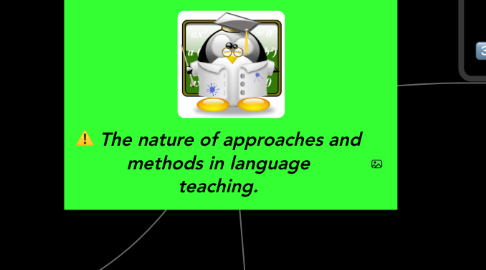
1. Definitions
1.1. Approach
1.1.1. It is the language itself. it is important to know why to use that approach. It is axiomatic/philosofic
1.1.1.1. Grammar Translation method: Only read and translate a text. It was the first language teaching approach
1.1.1.2. Audiolingual: Behaviourism; repetition
1.1.1.3. TPR
1.1.1.4. Silent Way
1.1.1.5. Suggestopedia
1.1.1.6. Communicative approach
1.1.1.6.1. Task based
1.1.1.6.2. Cooperative
1.2. Method
1.2.1. Way of applying an approach. it is procedural. it is more based on real language use and needs.
1.3. Technique
1.3.1. What is done in the classroom. Authentic use of language
1.3.1.1. Excersices in class
1.3.1.1.1. Tasks
1.3.1.1.2. Activities
1.4. Procedure
1.4.1. Moment-to-moment techniques
1.5. Nuevo nodo
2. Teacher and learner roles
2.1. Teacher Roles
2.1.1. For some methods, the role of teacher has been specified in detail.
2.1.2. Defined by the interaction in classroom with the students:
2.1.2.1. Define the types of functions
2.1.2.2. Degree of control that teachers have in the learning process
2.1.2.3. Degree of control in the content to be taugth
2.1.2.4. Interactional patterns between teacher and learner
2.2. Learner Roles
2.2.1. Degree of Ss influence
2.2.2. How learners are regarded
2.2.3. They plan and assume their learbning process
2.2.4. Monitor their learning
2.2.5. Learners tutor other learners
2.2.6. Dependency of the teacher (from 1 to 5)
3. Theory of language/ language learning
3.1. Structural
3.1.1. Achieve the elements of the system
3.1.1.1. Grammar
3.1.1.2. Phonology
3.1.1.3. Lexis
3.1.1.4. Sintax
3.2. Functional
3.2.1. Accomplish certain functions (Wilkin, 1972)
3.2.1.1. Semantics
3.2.1.2. Communication
3.2.1.2.1. Speech acts
3.3. Interactional
3.3.1. Tool for social relations and transactions It relates the 4 skills.(Vigotsky & Austin).
3.3.1.1. Interactional analysis
3.3.1.2. Discourse analysis
3.3.1.3. Problem solving activities
3.3.1.4. Pragmatics
3.4. Language learning
3.4.1. Takes into account an approach or a method: How language is perceived
3.4.1.1. Psycolinguistics
3.4.1.2. Necessary conditions for learning to happen
4. Syllabus organization
4.1. Is the design that is concerned with the selection and grading of content. responses to the question: what to include in a language program?
4.1.1. Types of syllabus
4.1.1.1. Synthetic
4.1.1.1.1. (Product oriented syllabus)
4.1.1.2. Analytic
4.1.1.2.1. (Process oriented syllabus)
